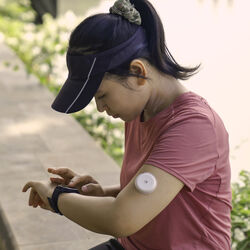
If you have diabetes, checking your blood sugar (glucose) levels may be one of the things you do to manage your disease. Drawing a drop of blood from your finger isn't the only way to check your glucose. Some people with diabetes use a continuous glucose monitor (CGM) to monitor their blood sugar.
Wondering if a CGM might be an option for you? Here are answers to some common questions.
Q. What is a CGM?
A CGM is a wearable device that checks your glucose level in real time throughout the day and night. You can see right away if your blood sugar is rising or falling, which may allow you to adjust your treatment, according to the American Diabetes Association. This could lead to fewer diabetes emergencies and complications.
Q. How do they work?
CGMs measure the glucose in the fluid in between your cells (interstitial fluid), typically every few minutes. Scientists have confirmed that measuring this fluid provides a good estimate of the glucose level in your blood.
To collect this data, CGMs have a sensor that is inserted under the skin of your belly or arm and attached with a patch. (Some people say the sensor feels like a pinprick when it goes in.) The sensor transmits your glucose data wirelessly to a special receiver or to your smartphone, so you can see the readings. Some CGMs send this data automatically. With others, you may have to scan the device with your phone to see your glucose readings.
Many CGMs use disposable sensors, which may need to be replaced every few weeks, according to the National Institute of Diabetes and Digestive and Kidney Diseases. Other CGMs have a sensor your doctor implants under your skin.
Q. What are the benefits of continuous glucose monitoring?
A CGM lets you see how your glucose is doing throughout the day—without sticking your finger. This may help people with diabetes maintain better blood sugar control. And it may help them avoid or delay some diabetes complications.
Continuous monitoring can help people with diabetes recognize changes in blood sugar as they happen. That can help them avoid emergencies such as hypoglycemia (low blood sugar.)
And, over time, a CGM can make it easier to spot trends. If you have diabetes, recognizing those patterns could help you adjust your diet or medications to better control your condition.
Q. Who might need a CGM?
One group of people who may benefit from using a CGM are those who use insulin to treat type 1 or type 2 diabetes.
The U.S. Food and Drug Administration has also approved an over-the-counter monitor for adults with diabetes who do not have an insulin requirement or a tendency to develop low blood sugar.
Adults who do not have diabetes can also use this OTC monitor—for example, to manage their prediabetes. However, researchers don't yet know if using a CGM has any medical benefits beyond helping people with diabetes manage their blood sugar.
Q. What are the cons of using a CGM?
The drawbacks depend on the type of device you have. For example, devices that measure your glucose automatically may have special features, like alarms, that you have to program. Setting these features up can be complicated. Also, these CGMs can be expensive, even when covered by insurance.
Q. Is a CGM right for me?
Talk to your doctor or a diabetes educator. They can help you decide if you could benefit from using a CGM to manage your diabetes.
For more on living your best with diabetes, visit our Diabetes health topic center.
Reviewed 7/11/2025
Sources
- AARP. "Who Really Needs a Continuous Glucose Monitor?" https://www.aarp.org/health/healthy-living/info-2023/who-needs-a-continuous-glucose-monitor-cgm.html.
- American Diabetes Association. "Continuous Glucose Monitors." https://diabetes.org/advocacy/cgm-continuous-glucose-monitors.
- American Diabetes Association. "Choosing a CGM." https://diabetes.org/about-diabetes/devices-technology/choosing-cgm.
- National Institute of Diabetes and Digestive and Kidney Diseases. "Continuous Glucose Monitoring." https://www.niddk.nih.gov/health-information/diabetes/overview/managing-diabetes/continuous-glucose-monitoring.
- U.S. Food and Drug Administration. "FDA Clears First Over-the-Counter Continuous Glucose Monitor." https://www.fda.gov/news-events/press-announcements/fda-clears-first-over-counter-continuous-glucose-monitor.